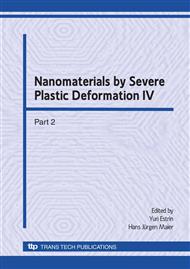p.387
p.393
p.399
p.405
p.411
p.417
p.422
p.428
p.434
TEM Studies on the Effect of Nature of Precipitates in Al-Li Alloy on Microstructural Evolution during Severe Plastic Deformation
Abstract:
Equal channel angular extrusion (ECAE), involving intense plastic straining under high applied pressure is generally recognized and extensively studied top down approach for producing bulk ultra-fine grained (UFG) metallic materials, and even going down in size to the nanometer range. In this research efforts are made to identify conditional under which grains with size less than 100 nm form after ECAE. Evolution of microstructure of Al-Li based alloy processed by ECAE is analyzed using transmission electron microscopy (TEM). Observations on the effect of precipitates/second phase particles in the sample on the deformation characteristics and their role on the increased degree of grain fragmentation process is highlighted. Samples of Al-Li based alloy are solutionized, quenched and aged at different temperatures to obtain well formed precipitate laths/plates before subjecting to ECAE. During the deformation process these precipitates disintegrate into fragments and get dispersed into the Al matrix. The fragments of a few nanometers size bring about drastic changes in the flow as well as the recovery characteristics of processed samples. Evidence for dynamic recrystallisation taking place during the ECAE processing is presented. It was observed that optimal thermal treatment leads to more effective grain refinement and consequently an ultra-fine grained microstructure could be achieved even after single pass in Al-Li based alloy containing precipitates and second phase particles.
Info:
Periodical:
Pages:
411-416
Citation:
Online since:
June 2008
Authors:
Price:
Сopyright:
© 2008 Trans Tech Publications Ltd. All Rights Reserved
Share:
Citation:


